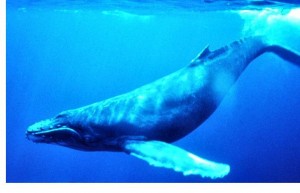TUESDAY, 19 APRIL 2011
 A decade’s worth of whale song recordings from six neighbouring populations in the Pacific Ocean have shown that male humpback whale songs spread from populations off the east coast of Australia to French Polynesia over about two years. Over the duration of the recordings only one song was ever noted to have moved the other way. Most new songs were found to originate from the previous year’s songs spliced with novel material; as a new tune arose it would quickly be adopted by the whole population, gaining in popularity until it effectively became number one and spread eastwards.
A decade’s worth of whale song recordings from six neighbouring populations in the Pacific Ocean have shown that male humpback whale songs spread from populations off the east coast of Australia to French Polynesia over about two years. Over the duration of the recordings only one song was ever noted to have moved the other way. Most new songs were found to originate from the previous year’s songs spliced with novel material; as a new tune arose it would quickly be adopted by the whole population, gaining in popularity until it effectively became number one and spread eastwards.It is thought that this cultural transmission of songs occurs with the migration of a small number of males from Australia moving to other populations, perhaps to seek new mates, rather than from the migration of entire populations. This may explain the rise in a new song over the course of one breeding season and likely reflects the efforts of a male to compose something different to attract females or repel rivals. Alternatively, whales in neighbouring populations may hear the new songs when their migration paths coincide [1].
This study is particularly significant because culture is something traditionally associated with primates [2]. This is the first time that such broad scale cultural transmission has been recorded in a species other than humans.
Written by Zoe Li
References:
- http://www.sciencedaily.com/releases/2011/04/110414131444.htm
- Dynamic horizontal cultural transmission of humpback whale song at the ocean basin scale. Garland, E.C., Goldizen, A.W., Rekdahl, M.L., Constantine, R., Garrigue, C., Daeschler Hauser, N., Poole, M.M., Robbins, J., & Noad, M.J. (2011) Current biology (In Press): CB doi:10.1016/j.cub.2011.03.019
